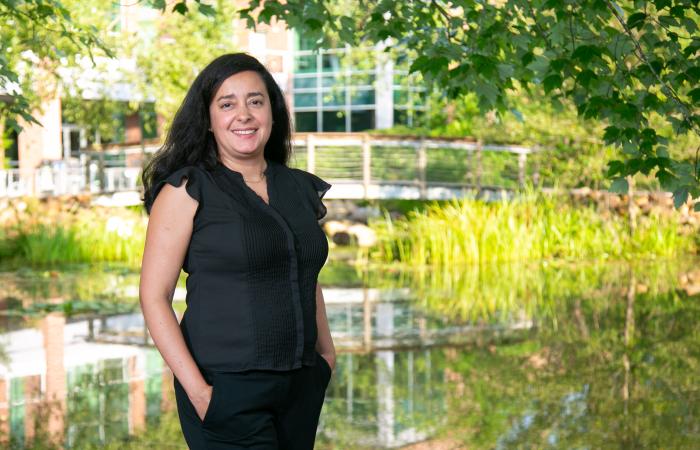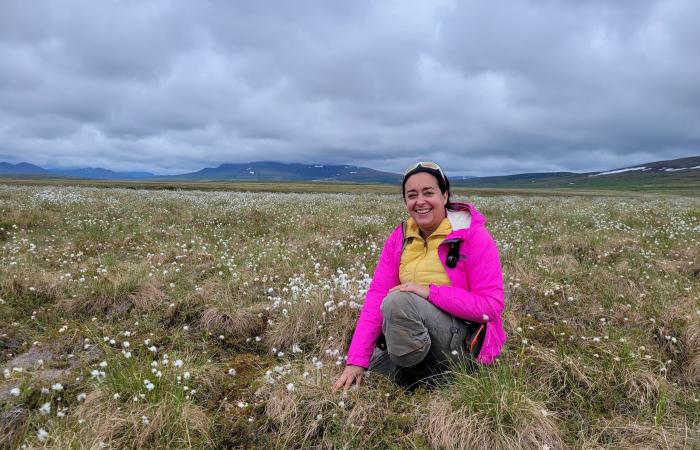-

ORNL's Fernanda Santos is studying how disturbances like wildfires affect belowground ecosystems and the soil carbon cycle. Credit: Genevieve Martin/ORNL, U.S. Dept. of Energy
-

Biogeochemist Fernanda Santos works at a soil sampling site in Alaska as part of the ORNL-led NGEE-Arctic project. Credit: Amy Breen/University of Alaska Fairbanks
-

ORNL's Fernanda Santos is studying how disturbances like wildfires affect belowground ecosystems and the soil carbon cycle. Credit: Genevieve Martin/ORNL, U.S. Dept. of Energy
-

Biogeochemist Fernanda Santos works at a soil sampling site in Alaska as part of the ORNL-led NGEE-Arctic project. Credit: Amy Breen/University of Alaska Fairbanks
With wildfires increasing in scope and intensity around the world, Fernanda Santos' research into how such calamities affect soil carbon storage has taken on new urgency.
The Oak Ridge National Laboratory soil biogeochemist has been digging into charred landscapes to better understand what happens to belowground biodiversity after such disturbances and how that affects the soil carbon cycle.
The Earth's soils hold more than 3 gigatons of carbon-triple the amount of carbon in the atmosphere. Scientists are eager to know how disturbances such as wildfires, especially repeated and severe fires, affect long-term carbon storage, and to incorporate that knowledge into predictive climate models.
"We know that microorganisms in soils and around plant roots play a key role in the carbon cycle. We're investigating what happens to carbon when microbial-mediated belowground processes and aboveground vegetation are disturbed. How will this ecosystem change if microbes and plants are stressed?" Santos said.
Her research has taken her to ecosystems in the mountains of Brazil, the upper peninsula of Michigan and the U.S. Southwest and Southeast. In June, she traveled to Alaska to sample soil in the tundra as part of the Next-Generation Ecosystem Experiments - Arctic project led by ORNL.
"It was the first time I'd been in a tundra ecosystem and my first encounter with permafrost," Santos said. "I was able to dig down only so far into the organic material before hitting something I thought was a rock but was actually frozen soil - it was very exciting."
She is analyzing how the active layer of soil near the surface, full of organic matter, is affected by wildfire and can even help fuel fires. She is also digging deeper into soil layers to unearth clues as to how fires in decades past influence carbon storage.
Developing a passion for soil science
Santos grew up in Brazil and attended the State University of Rio de Janeiro with the intention of becoming a geography teacher. But in one of the school's labs she noticed some shiny bricks on a table. They turned out to be soil samples embedded in resin, which enables researchers to better examine mineral content in different soil layers. Ensuing discussions with graduate students and professors, some borrowed books and a couple of weekend soil sampling trips later, Santos had her feet firmly planted on a new career path as a scientist.
"I was fascinated as I learned more about the importance of soil to our food system and to the climate," she said.
After earning her bachelor's degree, Santos attended Hunter College, part of the City University of New York, to earn a master's degree in physical geography. She stayed at CUNY to earn her doctorate in earth and environmental science, with a dissertation focused on carbon and nitrogen dynamics in soil organic matter.
She then worked at Michigan State University and the University of California-Merced as a postdoctoral research associate. At UC-Merced, she was a recipient of the prestigious Chancellor's Postdoctoral Fellowship, a two-year program that allowed her to expand the scope of her research, including a project that examined how wildfire altered stream chemistry and water quality in Yosemite National Park.
Santos has continued her research into the impact of wildfire on belowground carbon dynamics since her arrival at ORNL in January 2020. As part of that work, Santos and ORNL colleague Jiafu Mao hosted a workshop on wildfire impacts research, which led to the formation of the Fire Community Database Network. The network seeks to enlist researchers and land managers to compile a central repository of wildfire-related data such as satellite images and experimental research results to support disturbance ecology science.
"I'd like us to have a better understanding of how increased fires and other disturbances like flooding, logging and insect outbreaks in plants impact the release of carbon and other greenhouse gases, especially in the southeastern part of the U.S.," Santos said. "This is a missing piece now in our Earth system models and can help us make better projections of the future climate."
Cultivating community and opportunity
Santos has found a supportive community for her research since joining ORNL. "Everyone is focused on a common mission, and we check in on and support each other. I really appreciate that," she said. "I like to feel part of a community that communicates well and is engaged in solving important problems. This positive interaction helps me to keep my focus on my science."
In her spare time Santos loves to garden, explore area parks and hiking trails with her husband and young daughter, and swim. They enjoy the beaches at local lakes as well as swimming in area quarries.
Her gardening projects came with more digging. "When we settled here, we decided to plant more trees in our backyard. We ended up planting 12 of them. It was our own carbon sequestration project," Santos said. "I love seeing everything all blooming in the spring and watching the birds who frequent the backyard."
Her advice for scientists just starting out is to cultivate their own curiosity and to pursue good collaborations. "The world of science is very small, and every relationship is important."
Santos performed field work over several summers during grad school at the University of Michigan Biological Station near Pellston, where several manipulation experiments on ecosystem disturbance are underway. She is headed back to the station soon as she pursues a new project at ORNL.
"I did not think I would return to the University of Michigan Biological Station, but having a solid network there now makes it easy to re-enter that site. They are very excited to see me again," she said.
Santos likes to pass along advice she received from her mentor at UC-Merced, Dr. Asmeret Asefaw Berhe, now the director of the Office of Science at the Department of Energy. Berhe encouraged her to reapply for the school's postdoctoral fellowship after her first and second application were not selected. "Sometimes you need to knock on the same door several times to get what you want," Santos recalls Berhe saying.
Santos said "when you're a new scientist, you may not yet know how to navigate the system. It is easy to get discouraged. Finding good mentors is key, as is pursuing new opportunities and science areas you hadn't considered exploring before."






